Sports
Iranian reflects on her 4


msjeon22@korea.kr
For me, learning Korean wasn’t just about acquiring a new language but connecting with a culture renowned for creating cities where tradition and innovation coexist. Raised bilingual and learning English at age 8, I found Korean a challenge that stretched my cognitive abilities and introduce me to a starkly different linguistic system.I began with learning the alphabet Hangeul, which took just two hours thanks to a YouTube tutorial. I credit King Sejong for designing such an intuitive writing system. I categorized vowels and consonants by their shapes and sounds. For example, I grouped them based on how much I needed to open my mouth to differentiate.
Screenshots from YouTube video “2000 Essential Korean Words” (Darakwon)
While many start learning the language through Korean pop culture, my interest stemmed from curiosity. As an urban planning major, I studied global cities. In 2020, I was helping a professor translate a book and read a chapter titled “Right Place, Right Time: The Rise of Bundang.” This section highlighted Korea’s ability to blend modern technology with cultural heritage, and its concept continues to inspire me.
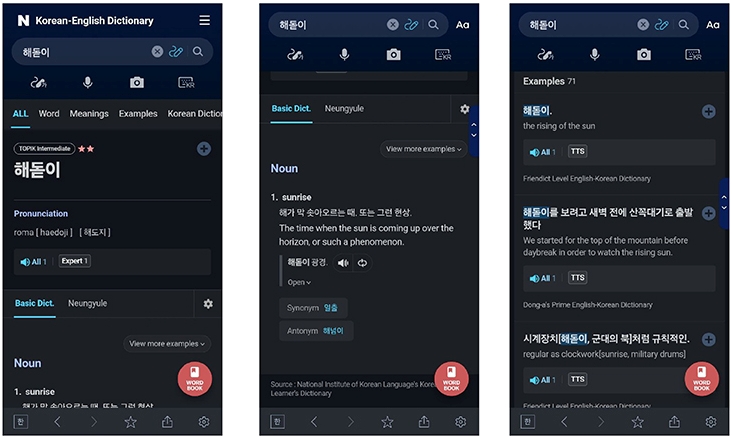
The best way to learn vocabulary is by creating multiple sentences with new words and applying grammar points. At first, I modified sample sentences from my books, but over time, I began creating my own sentences from scratch. After nearly four years of this method, I found that my sentence-making skill remained the strongest aspect of my journey.
For those learning Korean, I have a few tips based my experience. Take your time to build a strong foundation in grammar and vocabulary, as it requires patience and consistent effort. Language learning isn’t a race, so progress at your own pace and focus on steady improvement. *This article is written by a Korea.net Honorary Reporter. Our group of Honorary Reporters are from all around the world, and they share with Korea.net their love and passion for all things Korean.
By Honorary Reporter Sara Abbasvand from Iran
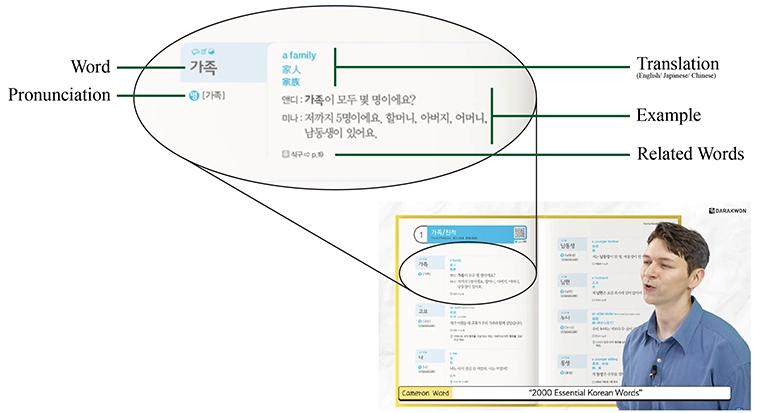
Screenshots from the app Naver Dictionary (Sara Abbasvand)
It’s been over four years since I began learning Korean, and this is my journey so far.
By integrating these methods, learning Korean can be both rewarding and sustainable.
Make the process enjoyable by switching up practice routines to maintain excitement and motivation. Use spaced repetition for reviews through apps, which offer pre-made vocabulary decks.
Expanding vocabulary was relatively easier, however, thanks to learning Hanja (Chinese script), which is often used alongside Hangeul in Korean. Instead of focusing on reading or writing Hanja, I concentrated on understanding related words, which significantly enriched my vocabulary.
Korean grammar, though generally simpler than English, has many rules with subtle differences in usage. I categorized these rules based on their use, formality and frequency. The Talk to Me in Korean textbook series, with 10 levels from basic to advanced grammar, was especially helpful in building a structured understanding.While learning Hangeul was quick, getting pronunciation rules took much longer than expected. Remembering and correctly applying all the rules at once was challenging. What helped the most was the app Naver Dictionary. The Korean-English version provided definitions, practical examples and multiple pronunciation audio bits including recordings from native speakers, making it a valuable tool for real-life language use.
Sports
The top indoor track and field meets to watch in 2026
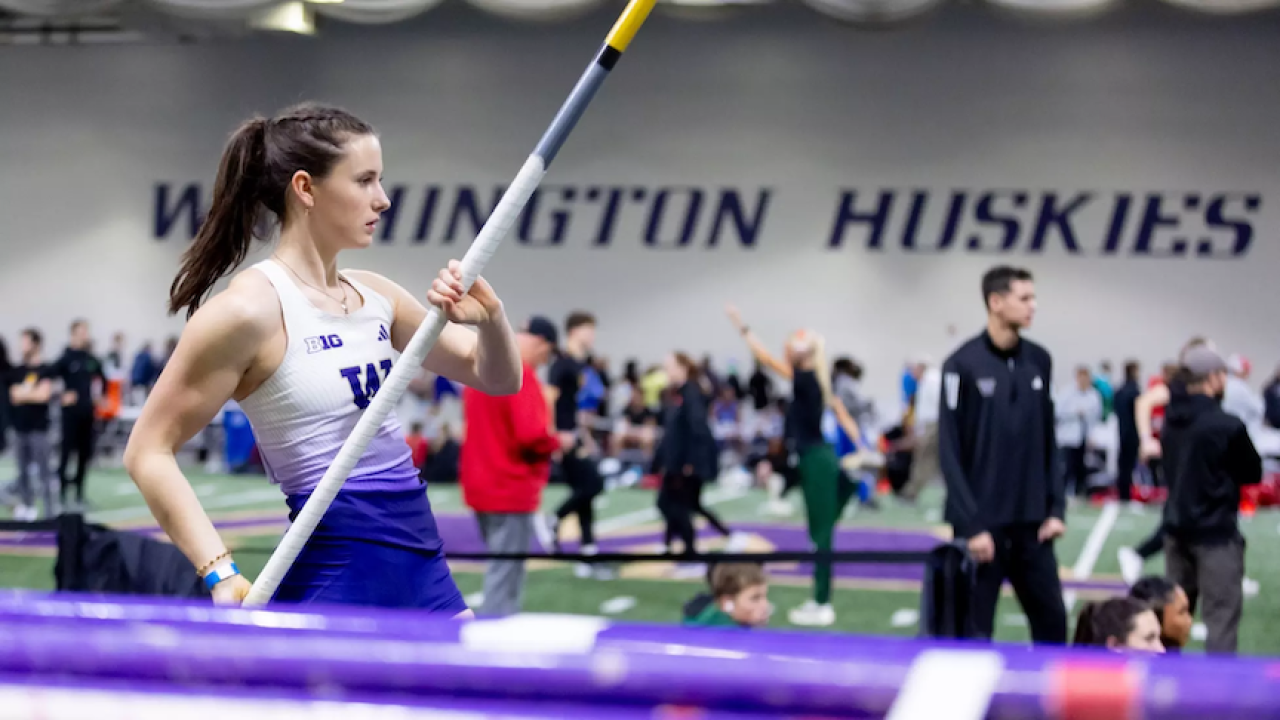
The 2026 NCAA indoor track and field season is here, and there is an exciting slate of meets ahead. Here are some meets that you don’t want to miss.
Top indoor track and field meets to watch in 2026
Season openers
- Clemson Opener | Dec. 5 | Host: Clemson
- HBCU & Ivy Challenge | Dec. 5 | Host: Harvard
- Sharon Colvear-Danville Season Opener | Dec. 6 | Host: Boston U
- The McFerrin Invitational | Dec. 6 | Host: Texas A&M
- JDL Early Bird Invitational | Dec. 6 | Host: Wake Forest
- Winter Commodore Challenge | Dec. 6 | Host: Vanderbilt
- Husker Holiday Open | Dec. 12 | Host: Nebraska
The indoor track season officially begins the first weekend of December. While we might not see every student-athlete begin their season this week, we’ll see plenty make their debut.
Return from the holidays
- Clemson Invitational | Jan. 9-10| Host: Clemson
- Rod McCravy Invitational | Jan. 9-10 | Host: Kentucky
- Leonard Hilton Memorial Invitational | Jan. 10 | Host: Houston
- Gamecock Opener | Jan. 10 | Host: South Carolina
- Arkansas Invitational | Jan. 16 | Host: Arkansas
- Corky Classic | Jan. 16-17 | Host: Texas Tech
- UW Indoor Preview | Jan. 16-17 | Host: Washington
- Virginia Tech Invitational | Jan. 16-17 | Host: Virginia Tech
After a holiday break, some of the best indoor track and field facilities in the country host meets. South Carolina’s two flagship schools should produce fast times at their meets. Rod McCravy is always exciting, too. In the middle of the month, we’ll see Arkansas — the future site of this year’s indoor championships — host the Arkansas Invitational.
Mid-season races
- Ted Nelson Invitational | Jan. 23-24 | Host: Texas A&M
- Dr. Sander Invitational Columbia Challenge | Jan. 23-24 | Host: Columbia
- Dr. Martin Luther King Jr. Invitational | Jan. 23-24 | Host: New Mexico
- Razorback Invitational | Jan. 30-31 | Host: Arkansas
- New Mexico Team Open | Jan. 30-31| Host: New Mexico
- Bob Pollock Invitational | Jan. 30-31 | Host: Clemson
- John Thomas Terrier Classic | Jan. 30-Feb. 1| Host: Boston U
- DeLoss Doggs Invite | Jan. 30-31 | Host: Kansas State
- 117th Millrose Games | Feb. 1 | The Armory in NYC
- New Mexico Collegiate Classic | Feb. 6-7 | Host: New Mexico
- Charlie Thomas Invitational | Feb. 6-7 | Host: Texas A&M
- Carolina Classic | Feb. 6-7 | South Carolina
By late January, indoor track teams will have long knocked off any rust and will be deep into the regular season. The end of January provides exciting meets in all corners of the country that will showcase sprinters, distance runners and more.
We can’t forget about the historic Millrose Games to start February, either. The iconic meet in The Armory is can’t miss.
The busiest weekend in indoor track and field
- Tyson Invitational | Feb. 13-14 | Host: Arkansas
- David Henry Valentine Invitational | Feb. 13-14 | Host: Boston U
- Don Kirby Elite Invitational |Feb. 13-14| Host: New Mexico
- Jarvis Scott Invitational|Feb. 13-14| Host: Texas Tech
- Husky Classic |Feb. 13-14| Host: Washington
- Tiger Paw Invitational |Feb. 14-15| Host: Clemson
- Music City Challenge | Feb. 14-15 | Host: Vanderbilt
Exactly one month before the DI indoor track and field championships, it’ll be the busiest weekend in indoor collegiate track and field. Top-ranked teams and top athletes will go head-to-head. There are so many great meets this weekend that some teams are splitting up among multiple meets. Expect records to fall across the country.
Last chance meets
- Arkansas Qualifier | Feb. 20 | Host: Arkansas
- Alex Wilson Invitational | Feb. 20-21 | Host: Notre Dame
- Virginia Tech Challenge|Feb. 20-21| Host: Virginia Tech
- Terrier DMR Challenge |Feb. 22| Host: Boston U
- USC Invite | Feb. 22 | Host: South Carolina
This will be the final regular season weekend of the season, with last-chance meets running around the country. The Terrier DMR Challenge will give college teams one last chance to work on their DMR order, handoffs and more. With conference championships up next, this will be the final time for some DMR squads to qualify for nationals and the final weekend for some individuals to qualify for conference championships.
Postseason meets
Most DI conference championships will be run the weekend of Friday, Feb. 27.
Two weeks later, the DI indoor track and field championships will be held in Fayetteville, Arkansas starting March 13.
Sports
Graduate Assistant Coach of Track & Field and Cross Country in Winchester, VA for Shenandoah University Athletics

Details
Posted: 05-Dec-25
Location: Winchester, Virginia
Type: Full-time
Salary: Tuition Waiver + Stipend
Categories:
Coaching
Coaching – Cross Country
Coaching – Track & Field
Sector:
Collegiate Sports
Salary Details:
Full-time Graduate Tuition; $2,500 per semester stipend; $250 per semester meal plan.
Required Education:
4 Year Degree
Additional Information:
2 openings available.
Shenandoah University, a NCAA Division III institution and a member of the Old Dominion Athletic Conference, is searching for qualified applicants for a Graduate Assistant Coach of Men’s and Women’s Track & Field and Cross Country.
The Assistant Coach of Men’s and Women’s Track & Field and Cross Country will provide event-specific coaching in T&F/XC and provide administrative assistance for the overall Men’s and Women’s T&F/XC program. The Assistant will be responsible for assisting with all phases of the team, displaying strong leadership in the assisting of managing a successful college T&F/XC program which will include: coaching, providing support for the head coach, scouting, recruiting, instructing, conditioning, arranging travel, tracking equipment, and meet management. The primary event focus of this position will be event experience in distance or throws. Handle secondary and other duties as assigned.
Shenandoah University is committed to enriching its educational experience and culture through the diversity of its faculty, administration, and staff. All candidates are strongly encouraged to include a statement in their cover letters addressing ways in which they may be able to contribute to that commitment.
**Note: A pre-employment background check will be required and a satisfactory driving record may be required as a condition of hire.
Shenandoah University values the unique and diverse perspectives of individuals and communities locally and globally and seeks to foster mutual understanding in an inviting community where individuals are welcome and respected. The university does not discriminate on the basis of race, color, religion, sex, pregnancy, sexual orientation, gender identity, national origin, age, physical, or mental disability, genetic information, veteran’s status, or on any other basis protected under applicable law.
Qualifications:
- Bachelor’s degree required.
- Acceptance to graduate program at Shenandoah University.
- USATF Level 1 certification preferred.
About Shenandoah University Athletics
Shenandoah University is a private, nationally recognized university established in 1875 and located in Winchester, Virginia, with nearly 4,000 students in more than 100 academic programs in seven different schools. Shenandoah is an NCAA Division lll school and a member of the Old Dominion Athletic Conference.
Connections working at Shenandoah University Athletics
Sports
Colonels to Open Indoor Season in Boston & Louisville

RICHMOND, Ky. – The Eastern Kentucky University men’s and women’s track and field teams will begin the 2025-26 indoor season at the Boston University Sharon Colyear-Danvielle Season Opener and KTCCCA Commonwealth College Opener on Saturday.
Highlighting the group traveling to Boston is Taha Er Raouy, who will compete in the men’s elite-invite section of 3,000 meters.
The Moroccan native enters the indoor season after a successful 2025 cross-country season during which he was the ASUN Conference’s Male Runner of the Year and an All-American, finishing 21st at the NCAA National Championships.
He will also compete in the men’s 5,000 meters with teammates Brian Kimutai, a 2025 cross-country All-American, and Mario Priego.
Running in the men’s open 3,000 meters for EKU will be Hammish Murray.
On the women’s side, Edna Chelulei will make her indoor debut for 2025-26 in “Beantown” running in the 3,000 meters and 5,000 meters.
In the 2025 outdoor season, Chelulei was the ASUN’s Most Outstanding Freshman while being a Second Team All-American in the 10,000 meters and an Honorable Mention All-American in the 5,000 meters.
In the women’s 3,000 meters, Chelulei will be joined by Khadija Ennasri.
Up the road in Louisville, another crop of Colonels will be in action at the Commonwealth College Opener.
On the track, Irene Rubio-Miralles is entered for the women to compete in the mile, 1,000 meters, and 800 meters, with Isabelle Shearer competing in the 3,000 meters.
Jacob Tapscott will be the lone representative running on the men’s side from EKU, being slated for the mile and 1,000 meters.
It will be a busy day in the throws department with EKU competing in the weight throw and shot put.
Anaiya Adams, Eliza Hoffman, Haley Angel, Ava Phillips, Lexi Lawless, Lariah Wooden, Amya Livingston, and Kristan Simmons will compete in the women’s weight throw.
Meanwhile, Landon Adkins, Bill Kissick, JJ Love, Matt See, and Daroyce Flemons will compete in the men’s section of the event.
In the shot put, Ava Phillips, Kristan Simmons, Eliza Hoffman, Lexi Lawless, Amya Livingston, and Lariah Wooden will compete for the women, with Landon Adkins, Bill Kissick, JJ Love, and Matt See competing on the men’s side.
BU Sharon Colyear-Danville Season Opener
KTCCCA Commonwealth College Opener
| Event | Participants |
| 1 Mile (W) | Irene Rubio-Miralles |
| 1 Mile (M) | Jacob Tapscott |
| 1,000m (W) | Irene Rubio-Miralles |
| 1,000m (M) | Jacob Tapscott |
| 800m (W) | Irene Rubio-Miralles |
| 3,000m (W) | Isabelle Shearer |
| Weight Throw (W) | Anaiya Adams, Eliza Hoffman, Haley Angel, Ava Phillips, Lexi Lawless, Lariah Wooden, Amya Livingston, Kristan Simmons |
| Weight Throw (M) | Landon Adkins, Bill Kissick, JJ Love, Matt See, Daroyce Flemons |
| Shot Put (W) | Ava Phillips, Kristan Simmons, Eliza Hoffman, Lexi Lawless, Amya Livingston, Lariah Wooden |
| Shot Put (M) | Landon Adkins, Bill Kissick, JJ Love, Matt See |
Sports
No. 16 Kansas Cruises to 3-0 Win over High Point in NCAA Tournament First Round
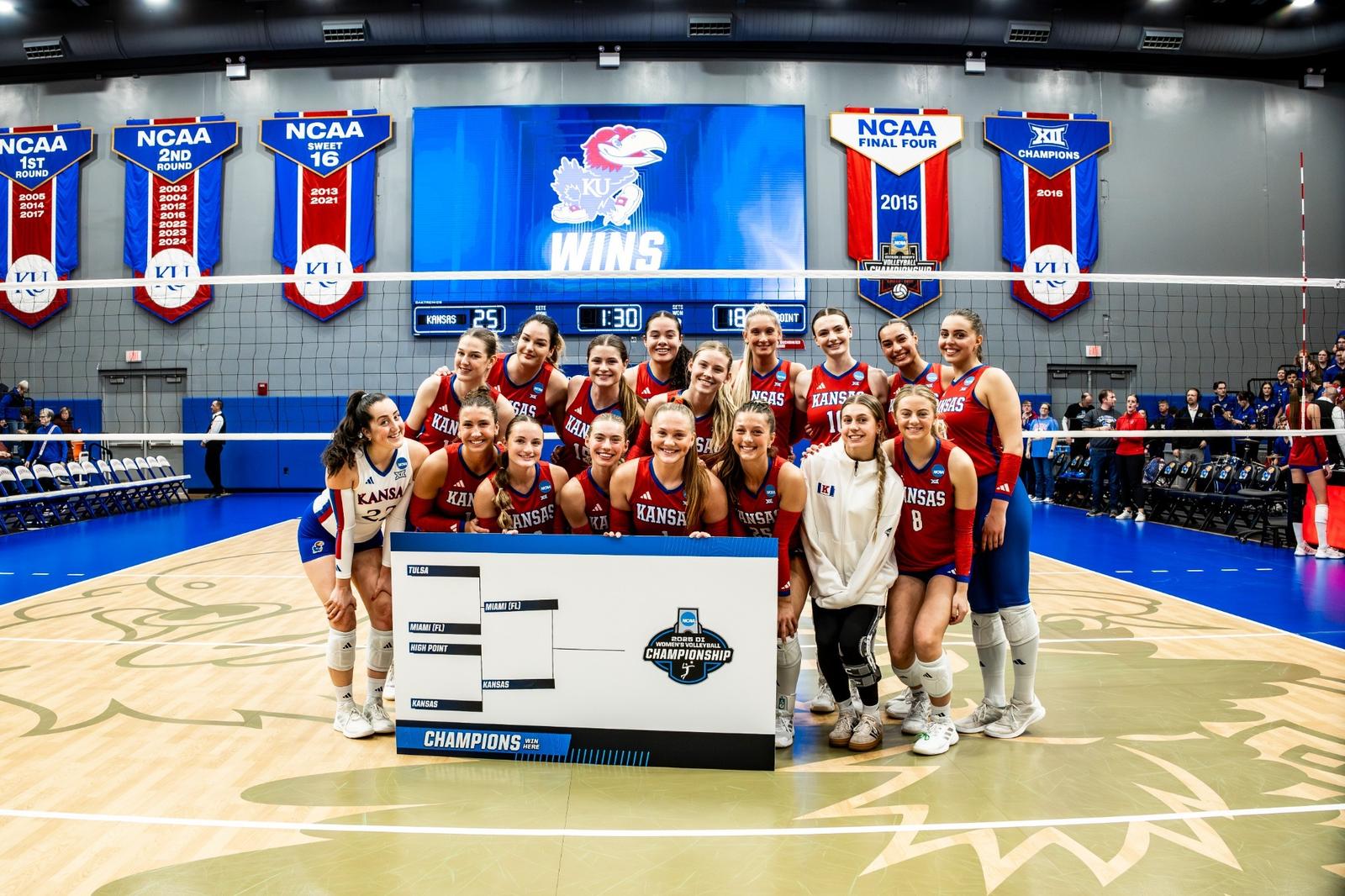
Kansas will take on Miami in the second round of the NCAA Tournament on Friday at 6 p.m. CT inside Horejsi Family Volleyball Arena. The match will air on ESPN+.
“Anytime you win a postseason match, it’s a big deal, and getting to do it at home makes it even sweeter,” said head coach Matt Ulmer. “High Point brought great energy with their band, and that pushed us, but I’m really proud of how we responded. It gives us a chance to chase something that’s really hard to do and go win the next one.”
Kansas’ balance showed throughout the sweep, led by Jovana Zelenovic’s efficient 8 kills on .400 hitting and three aces. Reese Ptacek added 7 kills and a pair of blocks, while middle blocker Aisha Aiono turned in one of the night’s strongest lines with 7 kills on .636 hitting and a team-high 6 blocks. Setter Katie Dalton guided the attack with 20 assists, 3 kills and an ace, and Selena Leban contributed 5 kills and solid back-row play. Libero Ryan White anchored the defense with 14 digs and added two service aces as Kansas finished with 36 kills, 9 blocks and 8 aces.
High Point jumped out to a quick 3–0 start, but Kansas settled in fast. A block from Aiono and Zelenovic put KU on the board, and the Jayhawks quickly found their rhythm from the service line as Zelenovic delivered back-to-back aces to tie it 4–4 and then give Kansas a 5-4 lead. KU continued to apply pressure with steady side-outs and clean execution. Reese Ptacek added multiple early kills, and another Kansas ace pushed the Jayhawks ahead 8–6.
High Point briefly tied the frame, but KU responded with kills from Ptacek, Swanson and Zelenovic to rebuild a multi-point cushion. Kansas controlled the pace through the midpoint of the set, forcing High Point into a timeout while holding a 12–9 advantage.
The teams continued to trade points late into the first set, until High Point drew within a point at 21-20. The Jayhawks rattled off two straight points following a pair of High Point attack errors to retake the advantage at 23-20 and force a Panther timeout. Kansas would close out the first set on a Zelenovic kill to take the opening set. By Kansas winning the first set, the Jayhawks handed High Point their first set loss since Oct. 31 vs. USC-Upstate.
In the second set, Kansas jumped out to a quick 3-0 lead. After High Point got on the board, Kansas rattled off five straight points to take an 8-1 lead into a High Point timeout. The Panthers were able to tie a few points together to cut their deficit in half at 12-6. Kansas continued to stay in control, getting kills from Zelenovic and Aiono to keep the margin comfortable at 15-8. The Jayhawks continued their success at the net with a pair of kills by Selena Leban and Addison Freeland to make the score 19-12. Kansas would later take the second set, 25-15 on a Katie Dalton service ace.
High Point jumped out to an early 7-3 advantage in the third set, until the Jayhawks cut into the deficit behind a block by Rhian Swanson and Aiono to make the score 8-6. Kansas would force High Point into a timeout with another block by Aiono and Zelenovic as Kansas trailed by 1, 10-9.
The Panthers would bounce back strong out of the timeout to extend their lead to 13-9. The Jayhawks would then rally for six-straight points to retake the lead at 15-13. After High Point evened the score at 17-17, Kansas scored three-straight points including back-to-back kills from Aiono to take a 20-17 lead and force a Panther timeout.
Kansas pushed its lead late in the third set to 23-18 on a Swanson kill on an assist from Dalton. The Jayhawks would take the third set on a kill by Aiono, securing the three set victory.
Up Next
Kansas will take on Miami at 6 p.m. CT on Friday at Horejsi Family Volleyball Arena. Miami defeated Tulsa, 3-1, in Thursday’s first round matchup.
Sports
Women’s Volleyball Falls to #4 Seed USC in NCAA Tournament First Round
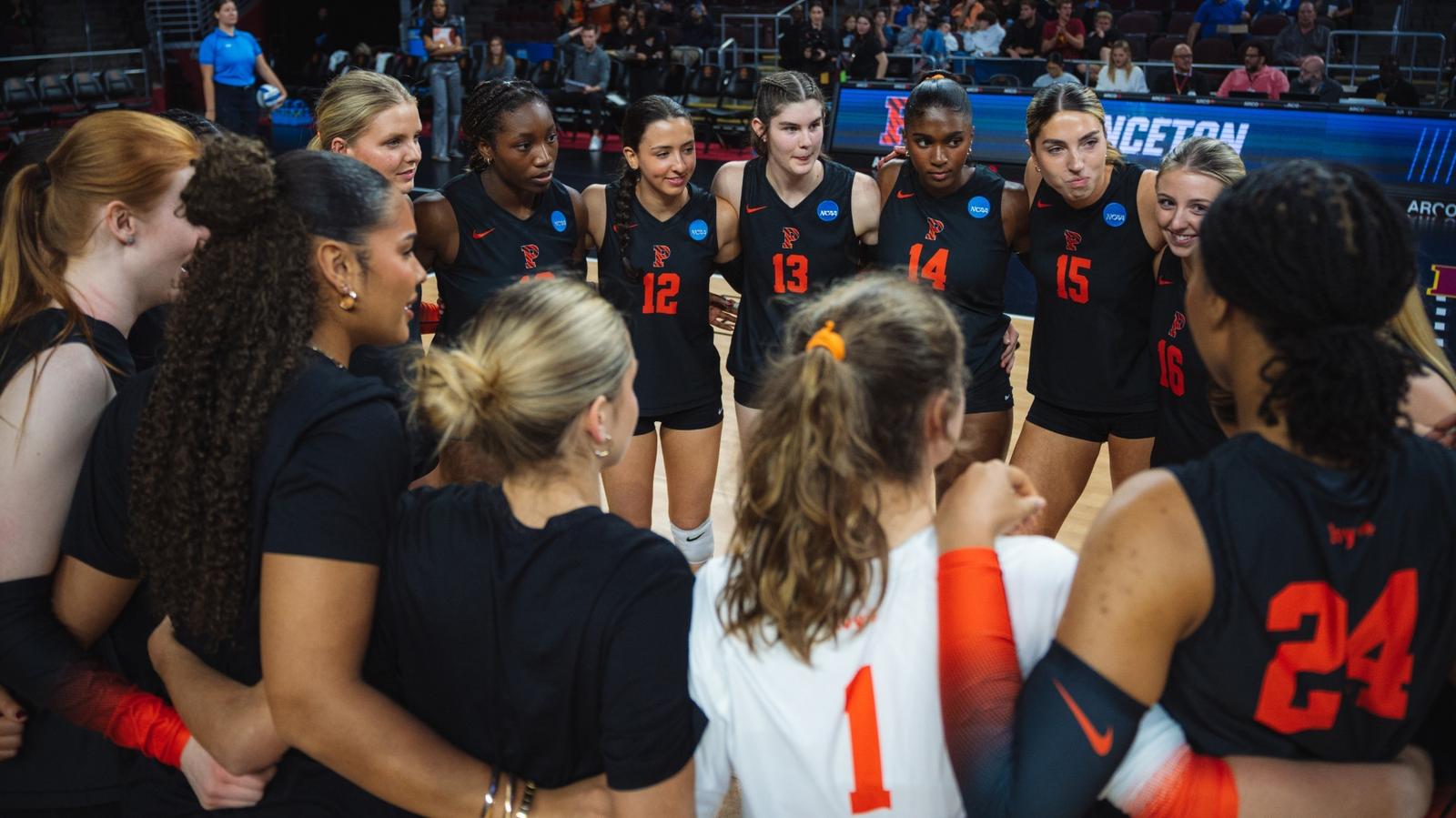
Along with the NCAA Tournament appearance being the Tigers’ ninth, it was Princeton’s fourth under Head Coach Sabrina King. In addition, the Tigers won the 2025 Ivy League Tournament and the regular season title outright.
Valerie Nutakor and Erin McNair tied for the team-high in kills with six each, while Sydney Draper led the team in assists with 15 and digs with 13 for her 12th double-double of the season
The Tigers kept it close early in the first set, battling the Trojans to trail by just one at 11-10. A 4-0 run by the Trojans gave USC a 15-10 advantage. Kills by McNair and Nutakor narrowed the deficit back down to three at 16-13, but the Trojans pulled away to earn the 25-19 first set victory.
Princeton again kept it close early, playing the Trojans to 11-8. A 5-0 USC run pushed the Trojans advantage out to 15-8, and USC did not look back from there as it went to prevail in the second set, 25-12.
The Tigers showed fight early, playing the Trojans to 16-12 after a kill by Nutakor. However, the night belonged to USC as the Trojans gain momentum and claim the 25-13 third set triumph to win the match, 3-0.
Sports
NCAA volleyball: BYU, Utah fall in 5-set tournament openers

PROVO — The BYU women’s volleyball’s stay in a 14th consecutive NCAA Tournament was cut short for a second straight year Thursday evening.
Kendall Beshear poured in 20 kills, 12 digs, four blocks, two assists and two aces to lift Cal Poly to a 25-19, 17-25, 20-25, 25-20, 15-10 win over fifth-seeded BYU at the Galen Center in Los Angeles.
Recently named Big 12 freshman of the year Suli Davis had 18 kills and 10 digs, Claire Little Chambers added 14 kills and 14 digs, and Brielle Kemavor supplied 15 kills and three blocks for the 22nd-ranked Cougars (22-9), who were fed by 48 assists and 11 digs from Alex Bower.
But for a second straight year, BYU was eliminated early by an upstart mid-major conference champion. A year after the Cougars were swept by A-10 champs Loyola Chicago, Cal Poly out-hit BYU .312 to .256 and served up seven aces with 12 blocks to send the top-25 team from the Big 12 home early.
Emma Fredrick added 15 kills and 10 digs for the Mustangs (26-7), and Emme Bullis dished out 52 assists with eight digs and a pair of aces.
BYU rallied from a 25-19 gut-punch in the opening set, when Bower fed a balanced attack of three double-digit hitters to take the next two sets, 25-17 and 25-20 on Little Chambers’ 12th kill of the match.
How efficient was BYU? In the third set, the Cougars hit .357 with 17 kills and just two errors to out-hit the Mustangs’ .257.
But the Big West champions found momentum in the fourth set, using a pair of aces and several other well-served balls to take a 13-9 lead early after a 4-0 spurt. The Cougars trailed 22-20 when Little Chambers had to be helped off the court with an apparent lower leg injury, and Ella Scott’s ace helped the Mustangs close out a 25-20 victory to force a decisive fifth set.
“Coming out of the third, we looked at each other and knew it was now or nothing,” Beshear told ESPN+ after the match. “We trusted each other, we balled out, and we had relentless defense. I think that’s what changed the game for us.”
Beshear had a service ace during a 4-0 run that gave the Mustangs an 11-6 lead in the finale, and Fredrick finished off the upset with her second ace of the night, 15-10.
Sixth-seeded Northern Iowa rallies to reverse sweep Utes
Lily Dykstra, Cassidy Hartman and Reese Booth each posted a double-double as sixth-seeded Northern Iowa rallied to reverse-sweep Utah 15-25, 21-25, 26-24, 25-20, 15-10 in Omaha, Nebraska.
Kamryn Gibadlo poured in 20 kills with four blocks for the Utes, who ended the season with a 15-15 overall record. Levani Key-Powell added 17 kills, and Emrie Moea’i had a double-double with 10 kills and 10 blocks for Utah.
“We are very proud to have gotten to the tournament,” said Utah coach Beth Launiere, whose team was back in the NCAA Tournament for the second straight season and 20th time in program history. “I think it’s been well-documented that we faced a lot of adversity this year. I couldn’t be more proud of my team for overcoming that, working together, finding a way, and getting us to this point.”
Utah Valley will be the fourth school from Utah to open the NCAA Tournament with first serve Friday at second-seeded Stanford.
-

 Rec Sports2 weeks ago
Rec Sports2 weeks agoFirst Tee Winter Registration is open
-

 Rec Sports1 week ago
Rec Sports1 week agoFargo girl, 13, dies after collapsing during school basketball game – Grand Forks Herald
-

 Motorsports1 week ago
Motorsports1 week agoCPG Brands Like Allegra Are Betting on F1 for the First Time
-

 Sports2 weeks ago
Sports2 weeks agoVolleyball Recaps – November 18
-

 Motorsports2 weeks ago
Motorsports2 weeks agoF1 Las Vegas: Verstappen win, Norris and Piastri DQ tighten 2025 title fight
-

 Sports1 week ago
Sports1 week agoTwo Pro Volleyball Leagues Serve Up Plans for Minnesota Teams
-

 Sports1 week ago
Sports1 week agoUtah State Announces 2025-26 Indoor Track & Field Schedule
-

 Sports1 week ago
Sports1 week agoSycamores unveil 2026 track and field schedule
-

 Sports1 week ago
Sports1 week agoTexas volleyball vs Kentucky game score: Live SEC tournament updates
-

 NIL5 days ago
NIL5 days agoBowl Projections: ESPN predicts 12-team College Football Playoff bracket, full bowl slate after Week 14
























































